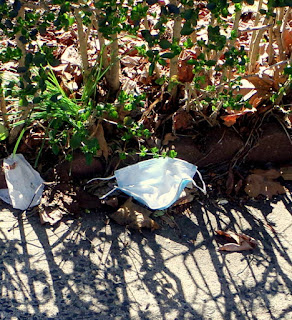Running an errand for an elderly relative of mine
yesterday—on a beautiful early spring day with blooming daffodils all around—I
called on a local drugstore and found its front door locked. Initially, I
assumed the place was shuttered—perhaps cutting back hours as other essential
businesses have. But then I noticed a handwritten sign on the door, which
said the drugstore was letting in a maximum of three to four people at a time.
Fair enough, I thought. There was a second handwritten note, which listed all
the things that were not available inside, including masks, gloves,
thermometers, and—you guessed it—toilet paper.
Now, this family-owned establishment has—even on its best
days—been a cramped environment, with men and women both sitting and standing
by the front counter awaiting their prescriptions. If the present
social-distancing recommendations—of maintaining at least six-feet distance
from our fellow human beings—were applied therein with, say, four customers
plus the staff on hand, a few of us would be across the street in the bodega
where I get my toilet paper. That business, by the way, is a confined
space, too, with individuals hanging around awaiting sandwiches instead of medications.
In the pre-coronavirus days, one didn’t give much thought to
loitering in the company of strangers in close quarters for several minutes at
a time. But that was then and this is now. Upon being let in by a young
masked-and-gloved woman who works in the drugstore, I handed over an empty
prescription bottle to be refilled to another young masked-and-gloved woman who works in the drugstore.
Meanwhile, the former masked-and-gloved woman—who unlocked the door for
me—frantically sprayed the air with some sort of disinfectant.
An actual pharmacist then called out to me from the back.
She would give me ninety pills, instead of the thirty refill listed on the
bottle, and fill another prescription—if I desired—that wasn’t due until next week. This change in policy was so that I would not have to return anytime soon and run—as it were—the
coronavirus gauntlet. Naturally, I jumped at the opportunity. Being in this
drugstore—with men and women picking up meds for ailments unrelated to the
virus and behaving more bizarrely than the norm—felt a little too close for
comfort.
There were ubiquitous signs inside the drugstore importuning
the clientele not to touch this or that, including the electronic signature
machines. In the summer of 1969, the Apollo 11 astronauts were quarantined for three weeks
after visiting the moon. Science wasn’t taking any chances with the unknown—i.e.,
sprinkling moon dust in one’s hair could wait. In 2020, I was quarantined in a
drugstore for ten minutes that felt like three weeks. The staff couldn’t
wait to get me out of there and I couldn’t wait to oblige them.
Outside on the street and above the street, buses and the
subway—as always—ran. But subway ridership is down 88%.
Passengers now enter only the back doors of buses, which look pretty empty as a rule, and are unable to sit in the
front. This reasonable measure is to protect the drivers from the infected masses.
It’s kind of surreal watching all of this play out in real time. Trains and
buses pass by as usual, but there’s nothing usual about it. And let’s
give the mail carriers their due, delivering as ever—uninterrupted: “Neither
snow nor rain nor heat nor gloom of night nor coronavirus stays these
couriers from their swift completion of their appointed rounds.” My late
father—a postman—would be proud.
(Photos from the personal collection of Nicholas Nigro)




No comments:
Post a Comment
Note: Only a member of this blog may post a comment.